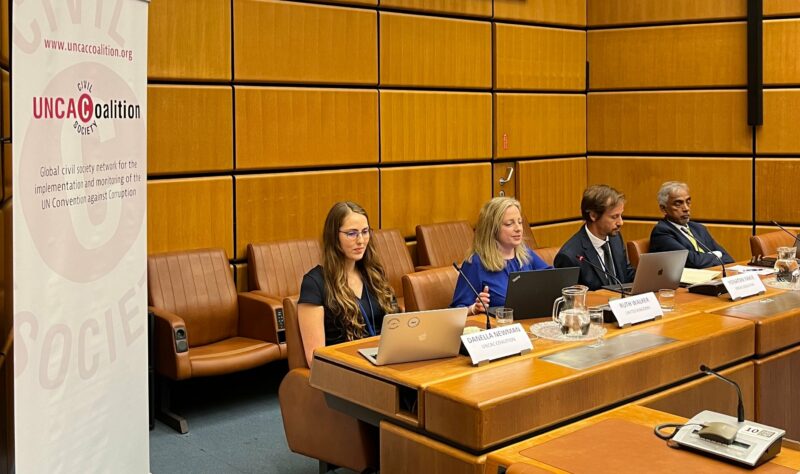
The Implementation Review Mechanism (IRM) is the mechanism by which States track implementation of the UN Convention against Corruption (UNCAC).
It has been successful in laying out hundreds of recommendations, identifying technical assistance needs and promoting anti-corruption reforms at the national level.
Nonetheless, the mechanism suffers from numerous weaknesses that prevent it from genuinely living up to its potential.
The UNCAC Coalition and the United Kingdom recently held a side event on this topic, exploring the weaknesses and potential of the UNCAC IRM.
Yonatan Yakir from the UNCAC Coalition, moderated the event, and panellists included:
- Danella Newman, UNCAC Coalition
- Ruth Walker, UK Foreign, Commonwealth and Development Office (FCDO)
- Navin Beekarry, Independent Commission against Corruption (ICAC), Mauritius
- Tetiana Khutor, Institute of Legislative Ideas (ILI), Ukraine
Key takeaways from the event included the following:
- The UNCAC review mechanism is a powerful force for anti-corruption reform.
- It suffers, however, from numerous weaknesses.
- Civil society is calling on UNCAC States Parties to use the historic opportunity presented by the next Conference of the States Parties (CoSP) to strengthen the next phase of the UNCAC IRM.
Weaknesses of the UNCAC review mechanism
The UNCAC review mechanism suffers from numerous weaknesses that prevent it from truly driving anti-corruption reform worldwide.
Danella Newman, Project Manager at the UNCAC Coalition, summarised the main weaknesses as follows:
1. Inclusion and civil society participation
States are not required to include non-governmental stakeholders in reviews. Even where stakeholders do participate, there are often challenges for their effective input, for example a lack of notice regarding opportunities to input, government presence at meetings etc.
2. Transparency
Country reports and self-assessment checklists are published on a voluntary basis, hindering access to important information. It is difficult for civil society to obtain information on the review process, for example, country focal point contact information, review timelines, etc.
3. Efficiency
Country reviews take a long time to complete, which undermines the process’s effectiveness and credibility. The average review takes 36 months rather than the 6-month timeline originally envisioned.
4. Lack of structured follow up mechanism
There is no official follow-up mechanism in place to track States’ implementation of recommendations.
How should the review mechanism be strengthened?
Speakers at the event raised different perspectives on how the review mechanism should be strengthened. The main ideas are summarized below:
Stakeholder participation
- Stakeholder participation should be guaranteed throughout the review process, including participation from civil society, academia, the media, and think tanks.
- Civil society should be allowed to participate in all CoSP subsidiary bodies, including the Implementation Review Group (IRG) and all Working Groups.
- There should be efforts to publicize how civil society and other non-state actors can participate in the process
- There should be a space in the self-assessment checklist for civil society to contribute its insights.
- Civil society should be able to hold meetings with review teams and provide written submissions.
Review visits
- These should be standard practice
Self-assessment checklist
- In addition to reflections regarding civil society input to self-assessment checklists, participants also raised the need for the self-assessment checklist to be reviewed to streamline input and processing.
Review timelines
- Country reviews should become more efficient.
- A yearly calendar should be published on the UNODC website.
Effectiveness
- Country reviews should assess the effectiveness of a country’s anti-corruption laws and practices.
Follow up process
- There should be a formal follow-up process on the implementation of reviews. This could include the following elements:
- Stakeholder dialogue to develop a follow-up action plan
- A self-assessment checklist for States to report on implementation (including a space for stakeholder assessments).
- Space in the context of the IRG for non-governmental stakeholders to advise on implementation and follow-up.
- Countries should present on progress at the IRG.
Transparency
- Both the executive summary and full country report should be published
Lessons learned from other review mechanisms
How do other review mechanisms approach the issues of transparency, inclusiveness and follow-up? Danella Newman highlighted what the UNCAC can learn.
Stakeholder engagement
- The monitoring mechanism for the Inter-American Convention against Corruption (MESISIC) and the Istanbul anti-corruption plan (a sub-regional peer review program) include civil society participation throughout the review process. Civil society is able to fill out stakeholder questionnaires, which can be included in final reports.
- In MESISIC, the Istanbul anti-corruption plan and the Universal Periodic Review (UPR), civil society can also make statements in the plenary when countries are being reviewed.
Transparency
- In MESICIC, the Istanbul anti-corruption plan and the UPR, full country reports are published.
Follow up
- In MESICIC, countries are required to submit annual progress reports regarding recommendation implementation, while in the mechanism for the Group of States against Corruption (GRECO) – the Council of Europe’s anti-corruption body – firm deadlines are set for reporting on compliance.
The potential of transparency and inclusiveness: national-level examples
How have transparency and inclusiveness in UNCAC reviews helped countries achieve their anti-corruption goals?
United Kingdom
Good practice
The UK has:
- Published its full country report
- Included civil society substantively in the review process
Mauritius
Good practice
- Included a wide range of stakeholders in the review process, including trade unions, civil society organizations, the private sector, academics and others.
Result
- Has obtained a broad range of perspectives regarding the best way to advance the fight against corruption in the country.
Ukraine
Good practice
- Ukraine’s National Anti-Corruption Prevention Agency (NACP) provided information to the Institute of Legislative Ideas (ILI) for a comprehensive parallel report on UNCAC implementation in the country.
- The NACP has also committed to running a joint UNCAC monitoring platform together with ILI.
Result
- This close collaboration between government and civil society has strengthened collaboration on UNCAC implementation in the country.



